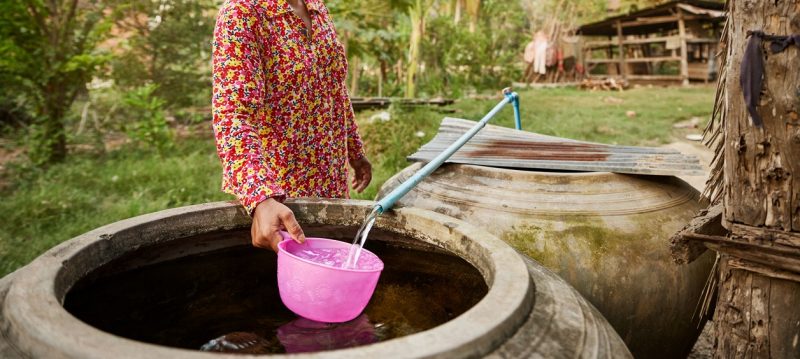Solution provider

We are a global water technology company committed to pioneering solutions to the world’s water and climate challenges and improving the quality of life for people.
Case
Non-revenue water
Water management
Water supply


We are a global water technology company committed to pioneering solutions to the world’s water and climate challenges and improving the quality of life for people.
Add the case to your visit request and let us know that you are interested in visiting Denmark
With a supply from Roka Khnong Lake, the plant used older models of pumps from Italy or China to distribute treated water out to the network. Everything was done manually. Using a combination of the pressure meter and a daily water use time table, the team would add or subtract pumps from the network throughout each daily cycle. Despite their best efforts, the team sometimes overestimated the pressure needed, resulting in pipe damage, non-revenue water (NRW) water losses and wasted energy. Takéo Safe Water Supply experienced a high NRW of an estimated 26%, high costs on pump spare parts for replacement, and also: unhappy customers in the villages farthest from the plant.
The village of Prek Pha-Aov is about 10 km (6.2 miles) from the plant. Previously, water flowed from the taps here only a few hours a day, making it hard for residents and local businesses alike. As a result residents paid extra money for water to be delivered to their houses.
“Before when there was no water, it was very difficult for me,” says Nab Orn, a local resident at her home. “It was like I wanted to use it, but there was no water. Nothing.”
The solution
Takéo Safe Water Supply teamed up with Grundfos to implement a well-tested technology – demand-driven distribution (DDD) – with a new financing model called a “Performance-Based Contract.”
For the DDD, Grundfos first conducted an audit of the Takéo plant’s pump system, including main data points such as pressure, flow and energy consumption, says Aloysius Chan, Manager of Grundfos Water Utility in South Asia. “This data actually gives a very close indication of the amounts of non-revenue water and energy consumption – which are the two key parameters when we are looking at water and energy savings.”
Based on the audit’s results, Grundfos installed a DDD system, including high-efficiency pumps for water distribution, control panels and pressure sensors. Grundfos installed the sensors at critical points in the network. In this case, one of them in the village Prek Pha-Aov. The sensor measures pressure and flow based on local water consumption and sends this information back to the control panel at the water plant. Over time, the system learns to predict the village’s consumption patterns from hour to hour. It adjusts overall system pressure – or switches pumps on or off to compensate – accordingly, says Chan.
For the station workers, it was at first hard to believe that the system could actually work automatically. After years of manual adjustments and guesswork, it was difficult to trust the system at first.
“Before installing it, I was afraid the water pipe might burst,” says Manager Sok Por. “If the pump supplying water at night is at high pressure but fewer customers are using it, I didn’t expect it to cut down by itself. I really didn’t expect that much. But it has proven to be wonderful, showing that it will produce according to needs. It is the complete opposite of what I thought.”
The outcome
The villages surrounding the water plant now have water 24 hours a day. Residents no longer have to buy extra water. They just have to turn on the tap.
“Now we have water, my family and I are comfortable,” says Nab Orn. “If we need to use water for boiling or for cooking, it’s not difficult like before. We can plant anything around the house – even in summer season. Also, some villagers want to run a business selling Kuy Teav (soup) or coffee. Now they have enough water to use.”
For the water plant, the system has meant savings in many areas – and a new way of working.
After one year, the plant has achieved the following: 20% savings in energy use, 13% reduction in NRW water losses due to leakages, and a 29% reduction in pipe bursts.
“I’m very satisfied with the installation of this new system,” says Sok Por. “Firstly, we save on electricity. Secondly, we save on raw materials – the chemical substances needed for treatment. Lastly, we cut down on losses. We supply the water based on the pressure needed from the customers. It flows exactly as they need. It is totally different than before.”
In addition, the DDD system has allowed the plant to “significantly” cut down on its workforce, he says, as his crew no longer needs to monitor the pumps at all hours of the day.
The plant’s technical manager, Mr. Sila, says, “We switched to a new technology so that we could earn a profit. Profit that we lost on electricity, chemicals, breakage or water leakage from pipes. We saved a lot after we installed the new technology.”
Mr. Sila adds, “We have made the price of producing water much cheaper and gained more profit, and we are able to provide a constant water supply, which makes our customers happy.”
The plant's Technical Manager Mr. Sila